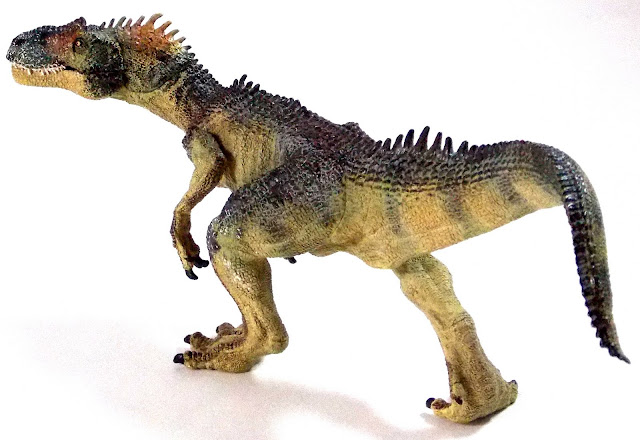Majungasaurus is on the list for weirdest theropod yet discovered. It is beat only by Masiakasaurus and perhaps the Therizinosaurs. Although the genus is not in the film, Jurassic World: The Game gives this animal to you as your first carnivore; a starting point from which it rapidly declines.
Before going into this model's inaccuracies, it should be pointed out that a good many of Ludia's models are just retools of the same model, done over and again. However, this does not excuse their laziness in the arms of the Tyrannosaur model.
Their Majungasaurus uses the model for Tyrannosaurus and many of the other large bulky theropods. This would be fine, except that they neglected to change the arms of the model, resulting in very long, noodle-like arms terminating in two fingered hands for all of the theropods using the model. Therefore, this Majungasaurus suffers from Broke-Wrist-Syndrome and its arms are FAR too long with FAR too few digits. Being an Abelisaur, Majungasaurus had extremely, and often comically, short arms, so short that the wrist, manus, and digits were all fused together into a vestigial 'paw' and would have looked almost non-existent.
 |
| Gah! Look at them teeny arms! Puts the Tyrant Lizard King to shame! |
As for the rest of the animal, since it uses the Tyrannosaurus model, it has a very short body with long thick legs. The real animal's skeleton was also very strange. It was one of the longest theropods proportionally to most others. It was very near the proportions of a dachshund, in which it had a very long tail, neck, torso, with somewhat thin squat legs and boxy skull. Since its discovery, the purpose for the knob on the top of skull of Majungasaurus is unknown, and it was likely covered with flesh and muscle since it is far too small to be used in either combat or for sexual display.
 |
| Art and Copyright belong to Compiler |
Evolved:
In Jurassic World: The Game, all animals can 'evolve' by combining two individuals of the same experience level. Once this occurs you get an animal with a better color scheme, with the last 'evolution' being an animal decked out in integumentary details. Majungasaurus is one of the most reserved of these 'Final Evolutions' and sports a row of spiky dermal osteoderms along its spine and a fancy new color scheme of bright blue, yellow, and a strange hue of pink near its muzzle. The spikes are not too much of a stretch since many Abelisaurs, specifically Carnotaurus, have shown to have scutes and armor on their dorsal and lateral sides.








